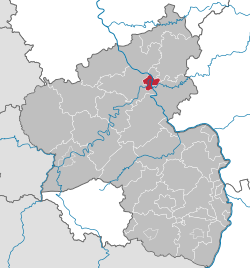Coblenz
| Koblenz | |||
|---|---|---|---|
 |
|||
|
|||
| Coordinates: 50°21′35″N 7°35′52″E / 50.35972°N 7.59778°ECoordinates: 50°21′35″N 7°35′52″E / 50.35972°N 7.59778°E | |||
| Country | Germany | ||
| State | Rhineland-Palatinate | ||
| District | Urban district | ||
| Government | |||
| • Lord Mayor | Joachim Hofmann-Göttig (SPD) | ||
| Area | |||
| • Total | 105.02 km2 (40.55 sq mi) | ||
| Elevation | 64.7 m (212.3 ft) | ||
| Population (2015-12-31) | |||
| • Total | 112,586 | ||
| • Density | 1,100/km2 (2,800/sq mi) | ||
| Time zone | CET/CEST (UTC+1/+2) | ||
| Postal codes | 56001–56077 | ||
| Dialling codes | 0261 | ||
| Vehicle registration | KO | ||
| Website | koblenz.de | ||
| Largest groups of foreign residents | |
| Nationality | Population (2014) |
|---|---|
|
|
1,525 |
|
|
849 |
|
|
572 |
|
|
521 |
|
|
519 |
Koblenz (German: Koblenz German pronunciation: [ˈkoːblɛnt͡s]), also spelled Coblenz (English and pre-1926 German spelling) or Coblence (French: Coblence), is a German city situated on both banks of the Rhine at its confluence with the Moselle, where the Deutsches Eck (German Corner) and its monument (Emperor William I on horseback) are situated.
As Koblenz was one of the military posts established by Drusus about 8 BC, the city celebrated its 2000th anniversary in 1992.
The name Koblenz originates from Latin (ad) confluentes,confluence or "(at the) merging of rivers". Subsequently, it was Covelenz and Cobelenz. In the local dialect the name is Kowelenz.
After Mainz and Ludwigshafen am Rhein, it is the third largest city in Rhineland-Palatinate, with a population of c. 106,000 (2006). Koblenz lies in the Rhineland.
Around 1000 BC, early fortifications were erected on the Festung Ehrenbreitstein hill on the opposite side of the Moselle. In 55 BC, Roman troops commanded by Julius Caesar reached the Rhine and built a bridge between Koblenz and Andernach. About 9 BC, the "Castellum apud Confluentes", was one of the military posts established by Drusus.
...
Wikipedia




